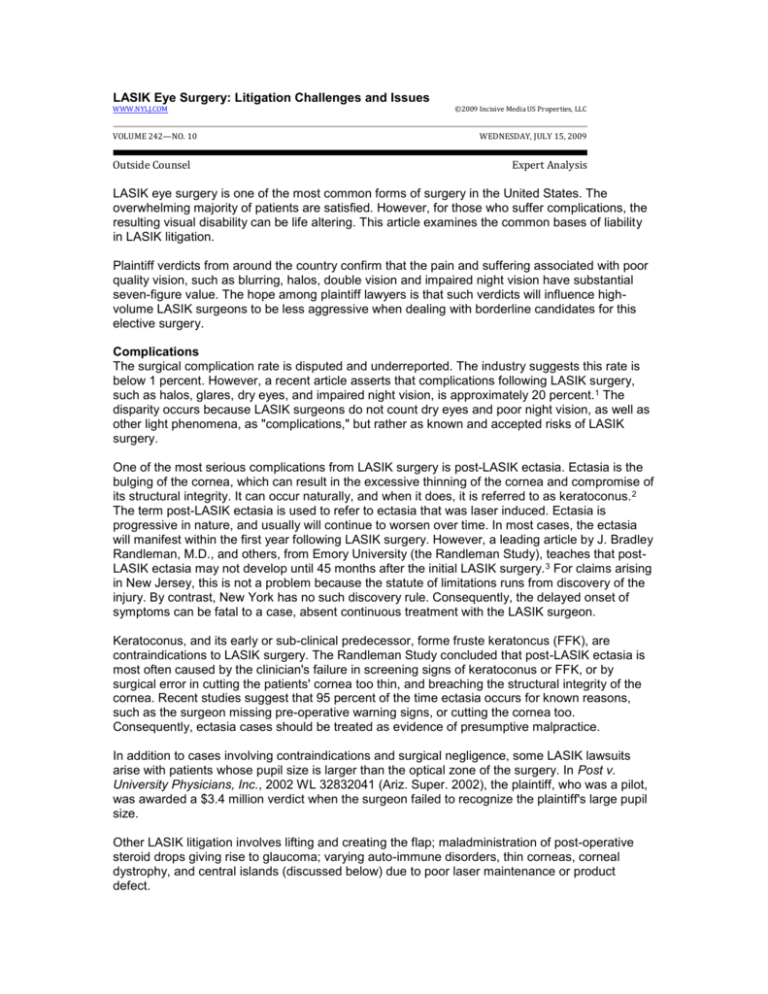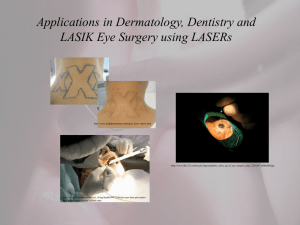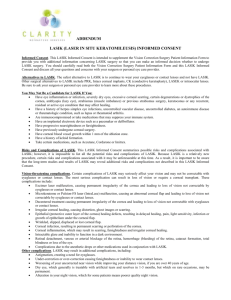
LASIK Eye Surgery: Litigation Challenges and Issues
WWW.NYLJ.COM
VOLUME 242—NO. 10
Outside Counsel
©2009 Incisive Media US Properties, LLC
WEDNESDAY, JULY 15, 2009
Expert Analysis
LASIK eye surgery is one of the most common forms of surgery in the United States. The
overwhelming majority of patients are satisfied. However, for those who suffer complications, the
resulting visual disability can be life altering. This article examines the common bases of liability
in LASIK litigation.
Plaintiff verdicts from around the country confirm that the pain and suffering associated with poor
quality vision, such as blurring, halos, double vision and impaired night vision have substantial
seven-figure value. The hope among plaintiff lawyers is that such verdicts will influence highvolume LASIK surgeons to be less aggressive when dealing with borderline candidates for this
elective surgery.
Complications
The surgical complication rate is disputed and underreported. The industry suggests this rate is
below 1 percent. However, a recent article asserts that complications following LASIK surgery,
such as halos, glares, dry eyes, and impaired night vision, is approximately 20 percent.1 The
disparity occurs because LASIK surgeons do not count dry eyes and poor night vision, as well as
other light phenomena, as "complications," but rather as known and accepted risks of LASIK
surgery.
One of the most serious complications from LASIK surgery is post-LASIK ectasia. Ectasia is the
bulging of the cornea, which can result in the excessive thinning of the cornea and compromise of
its structural integrity. It can occur naturally, and when it does, it is referred to as keratoconus. 2
The term post-LASIK ectasia is used to refer to ectasia that was laser induced. Ectasia is
progressive in nature, and usually will continue to worsen over time. In most cases, the ectasia
will manifest within the first year following LASIK surgery. However, a leading article by J. Bradley
Randleman, M.D., and others, from Emory University (the Randleman Study), teaches that postLASIK ectasia may not develop until 45 months after the initial LASIK surgery. 3 For claims arising
in New Jersey, this is not a problem because the statute of limitations runs from discovery of the
injury. By contrast, New York has no such discovery rule. Consequently, the delayed onset of
symptoms can be fatal to a case, absent continuous treatment with the LASIK surgeon.
Keratoconus, and its early or sub-clinical predecessor, forme fruste keratoncus (FFK), are
contraindications to LASIK surgery. The Randleman Study concluded that post-LASIK ectasia is
most often caused by the clinician's failure in screening signs of keratoconus or FFK, or by
surgical error in cutting the patients' cornea too thin, and breaching the structural integrity of the
cornea. Recent studies suggest that 95 percent of the time ectasia occurs for known reasons,
such as the surgeon missing pre-operative warning signs, or cutting the cornea too.
Consequently, ectasia cases should be treated as evidence of presumptive malpractice.
In addition to cases involving contraindications and surgical negligence, some LASIK lawsuits
arise with patients whose pupil size is larger than the optical zone of the surgery. In Post v.
University Physicians, Inc., 2002 WL 32832041 (Ariz. Super. 2002), the plaintiff, who was a pilot,
was awarded a $3.4 million verdict when the surgeon failed to recognize the plaintiff's large pupil
size.
Other LASIK litigation involves lifting and creating the flap; maladministration of post-operative
steroid drops giving rise to glaucoma; varying auto-immune disorders, thin corneas, corneal
dystrophy, and central islands (discussed below) due to poor laser maintenance or product
defect.
Product Defects
With today's laser technology, central islands are another injury, like ectasia, that rarely just
happen for no known reason. The term is used to describe elevations in the central treatment
zone of the cornea that can occur if the laser does not remove enough tissue in this area. The
'island' consists of a small mound of corneal tissue that can interfere with vision. Initially, central
islands were an unfortunate complication of the early technology that resulted from the uneven
application of the laser's energy. In recent years, this complication was thought to have been
eradicated due to advances in laser technology. Today, if central islands occur, they can be
assumed to be either a result of a product defect, or of the poor maintenance and cleaning of the
laser itself. In September 2007, Alcon Laboratories recalled its LADAR 6000 surgical laser,
because of reports that its laser created central islands.
Even though the Supreme Court has preempted product liability claims for medical devices in
Riegel v. Medtronic, Inc., 128 S. Ct. 999 (2008), claims against product manufacturers can
succeed under at least three theories. These include failure to manufacture the product in
accordance with the specifications submitted to and approved by the Food and Drug
Administration (FDA), failure to follow FDA protocols, and violations of parallel state law
consumer fraud statutes. In March 2009, the Medical Device Safety Act was introduced to
overturn Riegel, and reinstate injured patients' rights to recover for faulty medical devices.
In addition to Alcon's defective surgical laser, patients have developed central islands where a
well-designed laser was not maintained properly. The laser needs to be tested and calibrated
periodically. If this is not done, saline-like fluid has been known to splash on the laser optics and
impair the even flow of the laser energy, and has also resulted in central islands. Central islands
are one example of a corneal injury that, if severe enough, has no present cure or effective
treatment.
Effects on Individuals
Vision has two components, acuity (quantity) and quality. Post-LASIK complications can distort
the patient's vision, may impair visual acuity and will affect visual quality. Even if the patient can
read the letters on the Snellen eye chart, often it is accompanied with double vision, blurring,
ghosting, halos and various light phenomena including photosensitivity, difficulty with night vision,
and starbursting.4
In addition, there are a small, but alarming, number of patients who have committed suicide
allegedly due to LASIK complications. Although the industry asserts that suicide is a multi-factoral
issue, and that no such association between LASIK and suicide can be demonstrated, there
exists a clear correlation between visual impairment and depression.5 As other surgeons are
required to assess a patient's mental health before surgery, at minimum, it would be prudent for
LASIK surgeons to do the same.
Possible Treatments
Treatment is difficult for patients of LASIK malpractice. Glasses do not help. Contact lens therapy
is thwarted by dry eyes. Intacs offer another hope in stabilizing vision. Intacs are artificial lenses
implanted into the cornea in an attempt to reshape the cornea. In the worse case, a corneal
transplant surgery is necessary. Recently, the FDA has approved an experimental protocol to
arrest, but not cure, post-LASIK ectasia. It involves riboflavin drops and ultraviolet (UV) light. The
hope is that the combination of riboflavin and UV light will, on a microscopic level, increase the
levels of collagen in the cornea to strengthen the cornea and prevent further deterioration.
Jury Verdict Data
Juries in New York, and around the country, are recognizing the substantial value associated with
loss or impairment of vision. At the same time, it is difficult to explain to a jury how problems with
visual quality can ruin a patient's life, when the patient retains a reasonable visual acuity. Pictures
of these qualitative complaints, from the patient's eye doctor, or from the patient's environment
can be quite helpful.
In July 2005, a Manhattan jury awarded an investment banker $7.25 million in Schiffer v.
Speaker, where the author represented the plaintiff. The doctor was found negligent in screening
the patient, who had pre-operative FFK. The pain and suffering award alone was $3 million. The
award was affirmed in Schiffer v. Speaker, 36 A.D.3d 520 (1st Dept 2007). Last month, in a case
where the author represented the plaintiff, a Manhattan jury returned a verdict of approximately
$5.6 million in another ectasia case. The pain and suffering component in that case was also $3
million. Devadas v. Niksarli, Index No. 107637/07 (N.Y. Sup. Ct.) The post-trial process is at an
early stage.
In 2006, a jury in Nassau County returned a pain and suffering award of $3 million (which was
reduced to $2.1 million post-trial). Gropack v. Donnenfeld, Index No. 8476/02 (Sup. Ct. Nassau
Co. 2007) (J. Mahon). No meaningful claim for loss of income was reflected in that verdict.
Prior to the Schiffer case, a pilot was awarded $3.4 million for post-LASIK visual complaints. Post
v. University Physicians, Inc., 2002 WL 32832041 (Ariz. Super. 2002). Last year, a $2.1 million
settlement was reported in a LASIK malpractice case in New Jersey, against Dr. Joseph Dello
Russo. Russell Ben-Ali, "Lasik patient received $2.1M: Eye surgeon settles suit, does not admit
fault," The Star Ledger, 07/08/08.
In Crawford v. City of New York, 198 A.D.2d 48 (1st Dept. 1993), the plaintiff was awarded $1
million for pain and suffering for an injury to only one eye. In Cofsky v. Goosey, 2002 WL
32119471 (Texas Dist. 2002), the plaintiff received a settlement of $1.75 million. In Johnson v.
LCA Vision, Inc., 285 A.D.2d 971 (1st Dept. 2001), the New York Appellate Division held that a $1
million award for future pain and suffering for post-LASIK visual impairment in only one eye was
reasonable.
Multimillion-dollar verdicts have made LASIK surgeons less aggressive in operating on patients
whose screening is suspicious for FFK. In 2005, in response to the Schiffer v. Speaker verdict,
several ophthalmologists wrote and published an article in an attempt to reset the standard of
care. Binder, P, Lindstrom, R, et al., "Keratoconus and Corneal Ectasia After LASIK," Journal of
Refractive Surgery, Nov/Dec 2005, p. 749.
Retaliation
Finding a LASIK surgeon who is willing to testify on behalf of an injured patient is almost
impossible. Yet, without a reputable LASIK surgeon, the case cannot proceed. One of the most
significant impediments to retaining a LASIK expert to testify is retaliation. In Post, supra, TLC's
founder, Jeffrey Machat, M.D., testified in favor of the patient.6 As a result, his refractive surgeon
colleagues retaliated against him, cursed him, verbally assaulted him, and he was forced to
resign from TLC's advisory board. In other cases, experts have had invitations to present at
professional conferences revoked and been threatened with baseless ethics complaints.
Consequently, extraordinary efforts must be made to protect the identity of the few wellcredentialed experts who are willing to testify on behalf of plaintiffs. Protective orders should be
considered to insulate experts from retaliation.
FDA Advisory Panel Hearings
In April 2008, the FDA convened hearings in response to patient requests for a review of the
safety and effectiveness of LASIK surgery. As there have been increasing complaints of
dissatisfaction and suicide in connection with LASIK surgery, the FDA assembled members for
the Ophthalmic Device Panel to hear from various constituents. In response, the FDA has
commissioned a LASIK Study Task Force to evaluate quality of life after LASIK. To date, there
has been no report. Incidentally, all of the ophthalmologists on the Advisory Panel wore glasses.
Contrary to the Supreme Court's view in Riegel, supra, the FDA is ineffective. The recalled
LADAR 6000 surgical laser was approved without input from its Ophthalmic Device Panel. State
licensing agencies are indifferent to complaints of serial wrongdoers. A LASIK surgeon in
Chicago has been sued 43 times, and the Illinois Medical Disciplinary Board has seen no merit to
patient complaints. Governmental oversight is myopic.
Todd J. Krouner is a principal at the Law Office of Todd J. Krouner, in Chappaqua, N. Y. He
represented the plaintiffs in 'Schiffer v. Speaker' and 'Devadas v. Niksarli' which are discussed in
this article. Leigh Ryan, a law clerk at the firm, assisted in the preparation of this article.
1. Bailey M.D., Zadnik K. "Outcomes of LASIK for myopia with FDA-approved lasers,"
Cornea. 2007 Apr; 26(3):246-54.
2. For the purposes of this article, the terms "keratoconus" and "post-LASIK ectasia" will be
referred to by the term "ectasia."
3. Randleman JB, et. al. "Risk Factors and Prognosis for Corneal Ectasia after LASIK,"
Ophthalmology. 2003;110:267-275 at 269.
4. See, e.g., Abby Ellin, "L.ASIK Surgery: When the Fine Print Applies to You," N.Y. Times,
March 13, 2008.
5. Ingrid U. Scott, M.D. et al., "Quality of Life in Low Vision Patients and the Impact of Low
Vision Services," 128 American Journal of Ophthalmology 1 (1999).
6. TLC is a national provider of laser facilities. It is a public company whose shares trade on
the NASDAQ. Tiger Woods is one of their celebrity spokesmen. TLC was also a
codefendant in the Schiffer case.
Reprinted with permission from the July 15, 2009 edition of the NEW YORK LAW JOURNAL ©
2009. Incisive Media US Properties, LLC. All rights reserved. Further duplication without
permission is prohibited. For information, contact 877-257-3382 or
reprintscustomerservice@incisivemedia.com. # 070-08-09-36







